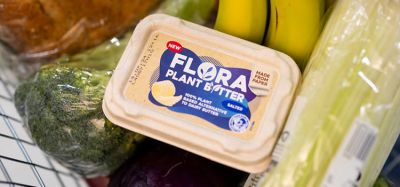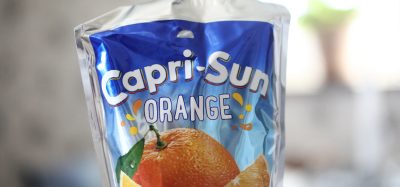Tribology: a new tool for the food rheologist’s toolbox
- Like
- Digg
- Del
- Tumblr
- VKontakte
- Buffer
- Love This
- Odnoklassniki
- Meneame
- Blogger
- Amazon
- Yahoo Mail
- Gmail
- AOL
- Newsvine
- HackerNews
- Evernote
- MySpace
- Mail.ru
- Viadeo
- Line
- Comments
- Yummly
- SMS
- Viber
- Telegram
- Subscribe
- Skype
- Facebook Messenger
- Kakao
- LiveJournal
- Yammer
- Edgar
- Fintel
- Mix
- Instapaper
- Copy Link
Posted: 23 June 2014 | Helen Joyner (Melito), School of Food Science, University of Idaho | No comments yet
Rheology is a powerful tool that can help link food physicochemical properties, structure, and sensory texture to form a cohesive, fundamental understanding of structural and physicochemical contributions to food texture. Yield stresses, fluid flow profiles, and fracture properties of firm solids are relatively easily determined with standard rheometry. However, there are still aspects of food texture that cannot be measured via standard rheological testing. Food texture in the later stages of mastication, when the food is being prepared for swallowing, shows poor correlation to mechanical measurements.
Additionally, certain aspects of mouthfeel, such as grittiness and astringency, are not detectable with rheometry2-6. For example, it is possible to design a fluid with the exact viscosity, sweetness, flavour, pH, and colour of pomegranate or cranberry juice. Rheological testing will not differentiate between the actual juice and the mock juice, but a simple sensory difference test will quickly confirm that the two liquids are indeed different. The difference lies in the mouthfeel: cranberry and pomegranate juices are astringent. Astringency, the feeling of mouth puckering or drying, is not detectable through rheometry, nor are many other mouthfeel terms such as grittiness or mouthcoat. A new tool is needed to provide mechanical measurements of astringency and other friction-based mouthfeel sensations.
Tribology, the study of friction, lubrication, and wear between two sliding surfaces, has been used for decades by the chemical and material engineering industries to determine the friction behaviour of various substances, such as lubricating oils and rubber8. Practical applications of this testing are relatively straightforward: lubricants that provide low amounts of friction between sliding steel surfaces are useful to reduce friction from surface-surface contact, such as in mechanical pivots or sliding pistons. Likewise, rubber for car tyres needs to provide sufficient friction for the tyres to grip the road, but not so much friction that rotation of the wheel requires significantly more energy and results in rapid wear of the tyres. More recently, tribology has been used in food research to study food friction behaviour. To date, tribological studies of foods comprise mainly model systems such as oil-in-water emulsions6,8-12, although various dairy products3,5,13,14, chocolate15, and mayonnaise3,4,16 have also been evaluated.
The most common tribological apparatus involves an indenter or ball that slides against a flat surface, with or without inclusion of a lubricant between the surfaces. Steel surfaces (hard contact) are generally used for tribological studies of machine wear and friction8. Tribological studies of foods, on the other hand, use elastomeric surfaces (soft contact), such as silicone rubber. These softer surfaces are considered to be a more accurate mimic of oral surfaces, and thus provide a better approximation of oral friction behaviour than hard contact surfaces2,11,17. Plots of friction coefficient (derived from torque measurements) versus sliding speed are generated from tribological data. These plots are called Stribeck curves and, for Newtonian fluids, have a similar shape to the plot shown in Figure 1. Stribeck curves have three distinct regimes2,8. At low sliding speeds, in the boundary regime (Figure 1a), friction is high due to contact between surface asperities and the thickness of the lubricating layer is insufficient to separate the surfaces. As sliding speed increases, the amount of fluid between the surfaces also increases, providing greater, but still incomplete, surface separation. This is the mixed regime (Figure 1b). At high sliding speeds, the surfaces completely separate, all hydrodynamic load is carried by the fluid, and lubrication behaviour shifts to the hydrodynamic regime (Figure 1c). Oral sliding speeds have been estimated to be between 30-100mm/s18, and food lubrication behaviour in the mouth is generally considered to be in the boundary-to-mixed regime2,8,19,20.
General assumptions behind the Stribeck curve and the calculation of friction coefficient include the use of hard (i.e. nondeformable) surfaces and Newtonian lubricants. However, tribological testing of foods is generally performed on elastomeric surfaces, as previously stated. Deformation of the surface can result in a change in contact area between the surfaces, which can affect friction measurements. Additionally, most foods are not Newtonian, and phenomena such as yield stresses and shear-thinning can significantly impact friction behaviour. There is also difficulty in measuring food friction behaviour at sliding speeds high enough to generate hydrodynamic behaviour. Thus, friction coefficients that are calculated using standard equations may not take the shape of the traditional Stribeck curve. There are methods to mitigate effects from surface deformation and non-Newtonian effects: contact area at each sliding speed may be calculated based on Hertzian theory21 and dynamic viscosity at high shear rates (>104 s-1) may be used to account for samples with different viscosity, or when viscosity changes with shear21,22. In addition, measuring food tribological properties at high sliding speeds may not be necessary to replicate the behaviour seen in the mouth, as the tongue is only capable of moving at sliding speeds up to 200mm/s23. Nevertheless, examining the friction behaviour of foods over the entire Stribeck curve may still be beneficial for properly describing oral friction behaviour, as multiple sliding speeds occur simultaneously during mastication.
One of the major objectives of food tribological research is to relate food sensory texture to mechanical friction measurements. A recent review of rheological and tribological contributions to food texture proposed that oral behaviour of food during the initial stage of oral processing is dominated by bulk rheological behaviour but tribological (thin-film) behaviour dominates during the later stages of mastication2. Thus, oral evaluation of foods involves sensation of both mechanical and friction behaviour, as well as compositional and physical properties (e.g. pH, particle size, fat content, and moisture content)2. This reasoning has led to the hypothesis that measuring food friction behaviour may yield information on food texture that is not provided by traditional mechanical testing2-6 and improve understanding of food structure-texture relationships.
Several studies have found relationships between emulsion mouthfeel terms and friction coefficient8,9,12,20. Fat content appears to be the major contributor to both emulsion texture and friction behaviour. Fat content has also been shown to have a significant impact on the friction behaviour of other foods such as milk5, custards3,13, mayonnaise4, and yogurt24: fat is an excellent oral lubricant and can significantly reduce friction coefficient. Particle size has also been found to impact friction behaviour3, although the results were not always compared to sensory texture data. Interestingly, large particles do not necessarily cause an increase in friction behaviour. Instead, the important factor to consider is particle shape and size in relation to gap height during sliding3. Particles that are larger than the gap between sliding surfaces are excluded from the gap, resulting in different friction behaviour than that measured at a larger gap (higher sliding speeds and a different lubrication regime)20. These results are especially important in fluid food design: care must be taken when measuring friction behaviour of fluids with relatively large particles and comparing the results to sensory texture. What may be detectable as a feeling of particles on the tongue may not be reflected in an increase in friction during mechanical testing (or vice versa) if the gap heights or sliding speeds used are dissimilar.
There has been less study on the effect of nonfat ingredients (e.g. starch, proteins, hydrocolloids) on food friction behaviour. Additionally, there has been little study on the relationships between friction behaviour and sensory texture. Studies examining the relationships between friction behaviour and sensory texture are mainly limited to foods with varying fat content. Fat content is a major driver behind sensory texture5,8,9, especially in fluid systems; however, other ingredients can also significantly contribute to sensory texture. Structural features, e.g. a weak gel network or protein conformation, can also impact friction behaviour. Further study is needed to examine the effects of these ingredients on friction behaviour and determine their contribution to friction-based sensory terms.
Another factor in food texture that is beginning to receive more attention in tribological studies is the contribution of saliva to food texture and textural changes. Saliva, a viscoelastic fluid, is more than 99 per cent water25. The remaining fraction comprises buffering salts, enzymes, mucins, other glycoproteins, immunoglobulins, and peptides25,26. Mucins in particular are primarily responsible for saliva’s characteristic mechanical behaviour26. When saliva is mixed with food during mastication, the resulting product usually possesses significantly different friction and mechanical behaviour than the original food, particularly during long mastication times (>10s). Nevertheless, saliva is generally not added to foods prior to or during mechanical testing even though the importance of saliva in food friction behaviour has been noted by several groups27,28. Additionally, studies on the friction behaviour of whole saliva, as well as saliva mixed with various foods have proposed that saliva, an excellent oral lubricant26, is a primary factor in oral lubrication processes24,29. Furthermore, food saliva interactions may impact food friction behaviour24. For example, the complexation of astringent compounds with saliva, resulting in an astringent mouthfeel, can be observed in tribological tests via an increase in friction coefficient upon addition of saliva to a solution containing astringent compounds27. In addition, food saliva mixtures have been shown to have different friction behaviour than either the food or saliva alone3,24. The changes in friction behaviour were shown to be from saliva itself rather than a dilution effect, supporting the idea that saliva significantly impacts friction behaviour.
Although testing foods with saliva may yield valuable information about changes in food frictional behaviour during the mastication process, saliva can be a difficult research material to use. In addition to varying among individuals, saliva composition is dependent on health status, hunger, stress, time of day, and mechanical stimulation in the oral cavity25,26. Carefully following saliva collection and storage protocols and pooling saliva from multiple volunteers can reduce the inherent variation in salivary composition. However, some variation in saliva composition, and thus behaviour, may still be present despite these precautions. On the other hand, an artificial saliva able to mimic the mechanical and friction behaviour of human saliva, as well as replicate the physicochemical changes in food caused by human saliva, is not currently available. Therefore, human saliva is used in tribological studies seeking to examine the effects of saliva on food friction behaviour.
Is tribology the Holy Grail of rheological testing? Will it be able to replace descriptive sensory analysis, the current gold standard for determining food texture? The most probable answer to both of these questions is no. The human mouth is a complex environment in which many physicochemical changes occur and multiple textural attributes are evaluated simultaneously. In fact, the capabilities of sensation and evaluation in the oral cavity rival the most modern food research lab facility: no single test or instrument is capable of simultaneously evaluating mechanical and friction behaviour, pH, volatile composition, fat and moisture content, and structure, as well as the changes in these properties over a range of timescales. However, combining the results of multiple tests gives a clearer picture of food texture and the mechanisms behind it. Although tribological testing may not be able to completely describe food texture, using tribology to evaluate food friction behaviour provides additional information on the role of friction in food texture, particularly when saliva is added during tribological testing. While not the Holy Grail of instrumental measurements, tribology is an additional tool for measuring the complex relationships between food physicochemical properties, structure, and texture.
References
- Chen, J., Food oral processing—A review. Food Hydrocolloids 2009, 23 (1), 1-25.
- Chen, J.; Stokes, J. R., Rheology and tribology: Two distinctive regimes of food texture sensation. Trends in Food Science & Technology 2012, 25 (1), 4-12.
- de Wijk, R. A.; Prinz, J. F., The role of friction in perceived oral texture. Food Quality and Preference 2005, 16 (2), 121-129.
- Terpstra, M. E. J.; Jellema, R. H.; Janssen, A. M.; de Wijk, R. A.; Prinz, J. F.; van der Linden, E., Prediction of texture perception of mayonnaises from rheological and novel instrumental measurements. Journal of Texture Studies 2009, 40 (1), 82-108.
- Chojnicka-Paszun, A.; de Jongh, H. H. J.; de Kruif, C. G., Sensory perception and lubrication properties of milk: Influence of fat content. 7th NIZO Dairy Conference 2012, 26 (1), 15-22.
- Dresselhuis, D. M.; de Hoog, E. H. A.; Cohen Stuart, M. A.; van Aken, G. A., Application of oral tissue in tribological measurements in an emulsion perception context. Food Hydrocolloids 2008, 22 (2), 323-335.
- Gibbins, H. L.; Carpenter, G. H., Alternative mechanisms of astringency – what is the role of saliva? Journal of Texture Studies 2013, 44 (5), 364-375.
- Dresselhuis, D.; Klok, H.; Stuart, M.; de Vries, R.; van Aken, G.; de Hoog, E., Tribology of o/w emulsions under mouth-like conditions: determinants of friction. Food Biophysics 2007, 2 (4), 158-171.
- Bellamy, M.; Godinot, N.; Mischler, S.; Martin, N.; Hartmann, C., Influence of emulsion composition on lubrication capacity and texture perception. International Journal of Food Science & Technology 2009, 44 (10), 1939-1949.
- Chojnicka, A.; de Jong, S.; de Kruif, C. G.; Visschers, R. W., Lubrication properties of protein aggregate dispersions in a soft contact. Journal of Agricultural and Food Chemistry 2008, 56 (4), 1274-1282.
- de Hoog, E. H. A.; Prinz, J. F.; Huntjens, L.; Dresselhuis, D. M.; Van Aken, G. A., Lubrication of oral surfaces by food emulsions: the importance of surface characteristics. Journal of Food Science 2006, 71 (7), E337-E341.
- Dresselhuis, D. M.; de Hoog, E. H. A.; Cohen Stuart, M. A.; Vingerhoeds, M. H.; van Aken, G. A., The occurrence of in-mouth coalescence of emulsion droplets in relation to perception of fat. Food Hydrocolloids 2008, 22 (6), 1170-1183.
- de Wijk, R. A.; Prinz, J. F.; Janssen, A. M., Explaining perceived oral texture of starch-based custard desserts from standard and novel instrumental tests. Food Hydrocolloids 2006, 20 (1), 24-34.
- Meyer, D.; Vermulst, J.; Tromp, R. H.; De Hoog, E. H. A., The effect of inulin on tribology and sensory profiles of skimmed milk. Journal of Texture Studies 2011, 42 (5), 387-393.
- Carvalho-da-Silva, A. M.; Van Damme, I.; Taylor, W.; Hort, J.; Wolf, B., Oral processing of two milk chocolate samples. Food & Function 2013, 4, 461-469; Luengo, G.; Tsuchiya, M.; Heuberger, M.; Israelachvili, J., Thin film rheology and tribology of chocolate. Journal of Food Science 1997, 62 (4), 767-812.
- Giasson, S.; Israelachvili, J.; Yoshizawa, H., Thin film morphology and tribology study of mayonnaise. Journal of Food Science 1997, 62 (4), 640-652.
- Garrec, D. A.; Norton, I. T., The influence of hydrocolloid hydrodynamics on lubrication. 10th International Hydrocolloids Conference 2012, 26 (2), 389-397.
- de Wijk, R. A.; Prinz, J. F., Mechanisms underlying the role of friction in oral texture. Journal of Texture Studies 2006, 37 (4), 413-427.
- Stokes, J. R., ‘Stokes, J. R., . Wiley‐Blackwell: Oxford, UK, 2012; p 265-287; Zinoviadou, K. G.; Janssen, A. M.; De Jongh, H. H. J., Tribological Properties of Neutral Polysaccharide Solutions under Simulated Oral Conditions. Journal of Food Science 2008, 73 (2), E88-E94.
- Malone, M. E.; Appelqvist, I. A. M.; Norton, I. T., Oral behaviour of food hydrocolloids and emulsions. Part 1. Lubrication and deposition considerations. 6th International Hydrocolloids Conference – Part 2 2003, 17 (6), 763-773.
- de Vicente, J.; Stokes, J. R.; Spikes, H. A., Soft lubrication of model hydrocolloids. Part Special issue: WCFS Food Summit 2006, 20 (4), 483-491.
- de Vicente, J.; Stokes, J. R.; Spikes, H. A., Lubrication properties of non-adsorbing polymer solutions in soft elastohydrodynamic (EHD) contacts. Tribology International 2005, 38 (5), 515-526; Davies, G. A.; Stokes, J. R., Thin film and high shear rheology of multiphase complex fluids. The A.S. Lodge Commemorative Meeting on Rheometry 2008, 148 (1–3), 73-87.
- Hiiemae, K. M.; Palmer, J. B., Tongue movements in feeding and speech. Critical Reviews in Oral Biology and Medicine 2003, 14 (6), 413-429.
- Selway, N.; Stokes, J. R., Insights into the dynamics of oral lubrication and mouthfeel using soft tribology: Differentiating semi-fluid foods with similar rheology. Food Research International 2013, 54 (1), 423-431.
- Humphrey, S. P.; Williamson, R. T., A review of saliva: Normal composition, flow, and function. The Journal of prosthetic dentistry 2001, 85 (2), 162-169.
- Schipper, R. G.; Silletti, E.; Vingerhoeds, M. H., Saliva as a research material: biochemical, physical, and practical aspects. Archives of Oral Biology 2007, 52 (12), 1114-1135.
- Vardhanabhuti, B.; Cox, P. W.; Norton, I. T.; Foegeding, E. A., Lubricating properties of human whole saliva as affected by β-lactoglobulin. Food Hydrocolloids 2011, 25 (6), 1499-1506; Rossetti, D.; Yakubov, G. E.; Stokes, J. R.; Williamson, A. M.; Fuller, G. G., Interaction of human whole saliva and astringent dietary compounds investigated by interfacial shear rheology. Food Hydrocolloids 2008, 22 (6), 1068-1078.
- Bongaerts, J.; Rossetti, D.; Stokes, J., The lubricating properties of human whole saliva. Tribology Letters 2007, 27 (3), 277-287.
- Ranc, H.; Elkhyay, A.; Servais, C.; Mac-Mary, S.; Launay, B.; Humbert, P., Friction coefficient and wettability of oral mucosal tissue: Changes induced by a salivary layer. Colloids and Surfaces A: Physicochemical and Engineering Aspects 2006, 276 (Issues 1–3), 155–161.
About the author
Helen Joyner has a B.S. in chemical engineering and an M.S. and Ph.D. in food science. She is currently an Assistant Professor at the University of Idaho in the School of Food Science. Her research focuses on rheological and tribological behaviour of food products, with the goal of determining relationships between structure, mechanical/friction behaviour, and sensory texture. The results of this research may be applied to many different food products, allowing more precise control of texture through structural manipulation.







